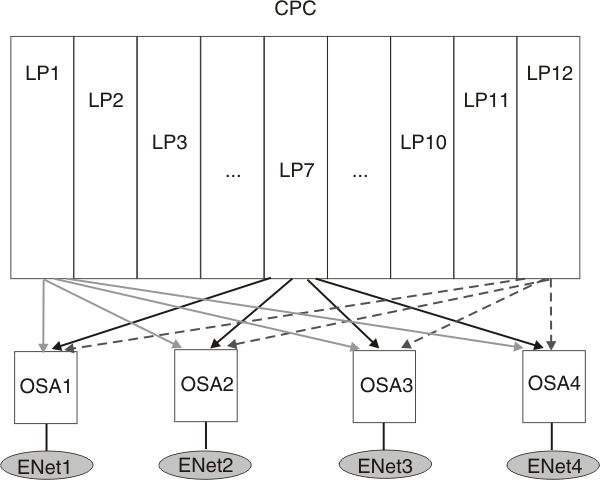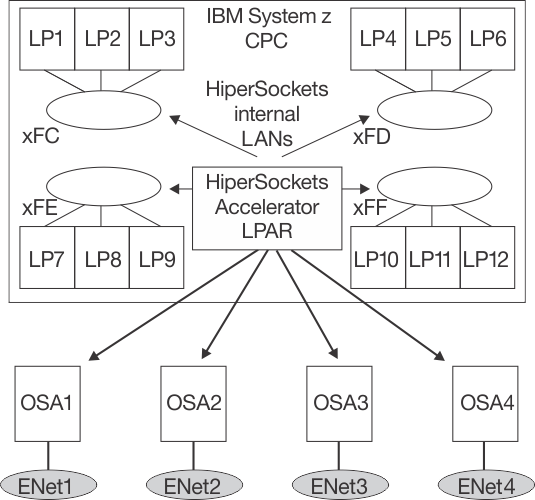Communications Server leverages the technological advances and high performing nature of the I/O processing offered by HiperSockets™ with the IBM® System z® servers and the IBM OSA-Express feature using QDIO architecture by optimizing IP packet forwarding processing that occurs across these two types of links. This function is referred to as HiperSockets Accelerator. It is a configurable option, and activated by configuring the IQDIORouting option on the IPCONFIG statement.
- HiperSockets Accelerator is IPv4 only.
- You cannot enable HiperSockets Accelerator if you enable IP security on the stack.
- You cannot enable HiperSockets Accelerator if IP forwarding is disabled on the stack.
When configured, it allows unicast IPv4 packets that are received over a HiperSockets link and are to be forwarded over a QDIO link (or received over QDIO and are to be forwarded over HiperSockets) to be forwarded by the z/OS® Communications Server HiperSockets device driver. That is, the IP forwarding function is pushed down as close to the hardware [or to the lowest software DLC (Data Link Control)] layer as possible so that these packets do not have to be processed by the TCP/IP stack or address space. Therefore, valuable TCP/IP resources (storage and machine cycles) are not expended for purposes of routing and forwarding packets. Figure 1 illustrates a configuration before the use of HiperSockets Accelerator.

HiperSockets Accelerator presents a different configuration and approach to obtain full connectivity, as shown in Figure 2.

This function allows a user to position a specific or single TCP/IP stack which has direct physical connectivity to the OSAs LANs as the HiperSockets router. This stack can then connect to all remaining TCP/IP stacks in other images (LPARs) within the same CPC that require connectivity to the same OSA LANs using HiperSockets connectivity.
This approach becomes more beneficial as the number of LPARs within a given CPC increase. Instead of attempting to directly attach each LPAR to each physical network attachment using an OSA LAN, a smaller number of OSAs could be concentrated through a single z/OS LPAR. From a performance perspective, HiperSockets Accelerator attempts to make the intermediate (or router) TCP/IP stack appear as if it did not exist in the path. Instead, each LPAR will appear as if each were directly attached to the physical network (for example, packets are forwarded without traversing the router TCP/IP stack). There are no additional routing configuration tasks required by the user. The prerouting occurs automatically. The TCP/IP stack automatically detects IP packet forwarding is occurring across a HiperSockets eligible route (QDIO/HiperSockets or HiperSockets/QDIO), and dynamically creates a HiperSockets Accelerator route entry. All subsequent packets will then take the optimized device driver path, and will not traverse the TCP/IP stack.
The dynamically created HiperSockets Accelerator routing entries can be displayed by the Netstat ROUTE/-r report option with the IQDIO modifier. VTAM® tuning statistics are provided to allow the user to monitor or measure prerouting activity.
QDIOPriority (IQDIORouting option) is an optional choice that allows the user to specify which of the four priority queues should be used when prerouting packets from a HiperSockets link outbound to a QDIO link. The default is 1 (highest priority), and in most cases should be sufficient.
For additional details regarding the IQDIORouting configuration option, see the IPCONFIG statement in z/OS Communications Server: IP Configuration Reference.
- If packet trace is enabled, then packets that are accelerated by HiperSockets Accelerator do not appear in the packet trace (either inbound or outbound). If you want function similar to that of the packet trace in conjunction with HiperSockets Accelerator, you can use the OSA-Express network traffic analyzer (OSAENTA) to trace these packets that are accelerated to or from OSA-Express QDIO. For more details on OSAENTA, see OSA-Express network traffic analyzer trace.
- QDIO Accelerator provides all of the function supported by HiperSockets Accelerator, and provides accelerated forwarding for other combinations of traffic involving QDIO devices, including sysplex distributor. QDIO Accelerator can also interoperate with IP security. For more information, see QDIO Accelerator.